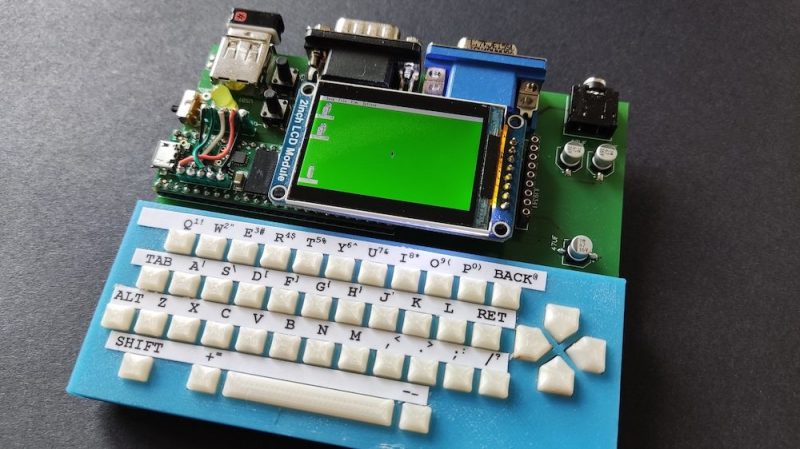Science fiction predicted that we would one day all carry around tiny computers of great power. While smartphones are great, those predictions were more based on cuter systems that more closely approximated existing computers, with keyboards and screens. [Jean-Marc Harvengt] has built something along those very lines, and it’s called the T-COMPUTER.
This build centers around the mighty Teensy 4.1. That means it’s got an 800 MHz Cortex-M7 processor, 1 MB of RAM, and 8 MB of flash – eclipsing the specs of many retrocomputers of yesteryear. [Jean-MarcHarvengt] has paired the Teensy with a 42-key keyboard and a TFT screen, making a compact handheld computer platform. It’s also got VGA out for display on a bigger screen, along with USB and an old-school Atari joystick port! Power is via a small rechargeable lithium cell on the back, and 16-bit stereo audio is available via a standard 3.5mm jack. There’s also a little GPIO available if you need to interface with something.
It’s capable of emulating the Commodore 64 and Super Nintendo, as well as more obscure systems like the Atari Lynx. And before you ask – yes, it can run DOOM. It’s a fun little platform that would be enjoyable for retrogaming and hacking on the go. If you want to build your own, files are readily available on Github to recreate the system.
Handheld computer builds are always growing in popularity now that so much computing power can be had in a tiny devboard formats. If you’ve built your own neat little rig, be sure to let us know! Video after the break.
[Thanks to Alex for the tip!]

















Now that looks more like an AIM-65.
I don’t like the screen, too small and impractical.
Get a proper VGA LCD. 7″ or bigger.. :)
They can be found in dead portable DVD players, for example.
Or in cheap rear-view monitors (see car accessories)
There are also industrial quantities of once useful 20″ or so LCD VGA screens for cheap that have been replaced by HDMI screens !
Uhh, that IS a 7″ VGA screen he’s using. The smaller screen is said to be a ‘TFT’ (looks like SPI interface, actually)
My bad. I meant a 7″ panel, as an internal screen.. Even our miniature monochrome CRTs from 20th century were usually providing a bigger diagonal screen area than that 2.x” screen. I mean, sure, it’s funny and cute. But nit practical. You can’t really see a desktop at this size. Both my late 90s PalmOS PDA and my Pocket PC had a bigger screen, in relation to the device, at the very least.
TFT and LCD are related technologies, afaik. LCD is often used as a general term, with TFT being a sub category (also marketed as active matrix LCD). There are also TN and IPS panels, in particular.. Both which are filters which require a background light, in contrast (pun intended!) to OLED technologies.
You must have poor eyesight. Some people can read 4-6 pt fonts easily.
This project is very cool, but I wonder about the actual use cases of the Teensy ??
Is it a good Arduino or a bad RasPi 0 ?
I don’t understand how it can be 2 times as expensive as the latter while offering less functions. I read the entire spec sheet : does it have something special I didn’t considered ?
Don’t get so caught up in brands. The “arduino” is USUALLY an 8-bit microcontroller, formerly from Atmel. They’re cheap and simple (and nice to use). The “Raspi 0” is a microcomputer, a system-on-module, with a powerful processor and many external peripherals using standard interfaces like PCIe. This, the “Teensy”, is a microcontroller breakout board. The chip is a microcontroller with a 32-bit ARM Cortex-x7 processors, with peripherals built around the processor within the same chip.
arduino is a very simple microcontroller, cortex 4/7/etc are a very complex microcontroller intended to run an embedded operating system or other high-performance code, a raspi0 is a high-performance processor meant to run a full operating system or other extremely high performance code.
There’s a world of other chips in between these three, and the easiest way to tell them apart is series. ARM has several, including the Cortex series, but there are 64 and even 128-bit architectures, as well as 8- or 4-bit architectures for extremely low power usage.
“Science fiction predicted that we would one day all carry around tiny computers of great power. While smartphones are great, those predictions were more based on cuter systems that more closely approximated existing computers, with keyboards and screens.”
Anyone remember PDAs with built in hardware keyboards?
https://www.youtube.com/watch?v=7VFs04quVYI
My HP100LX still works great, 28 years on.
I shudder to remember the expense tho. Inflation-adjusted, the 3-monitor i7 32GB beast I’m sitting in front of was half the cost.
I’m thinking of stuffing a Teensy4.1 or a Pi ZeroW into its PCMCIA slot.
(Sigh) If I had build skills…
I’d ditch the built-in keyboard, instead having a USB keyboard.
Then I’d add more USB ports, an SD card interface, to create an “Intellligent USB HUb”. Similar to a USB Dock.
The main difference? A key macro, switches from simple pass through to activated. You can have games, calculator, book reader, even encryption (between SD card and master PC).
In this mode, all the PC is doing is providing power – and even that could be done with a USB-C power supply.
Alas, without build skills, it will just remain an idea.
how long this device work on one charge?
exactly ;(
this is important paramater, everyting else is no problem ;D
I am really interesting in this. I’ve been wondering how to do video out on a Teensy.
Thanks for posting!!!